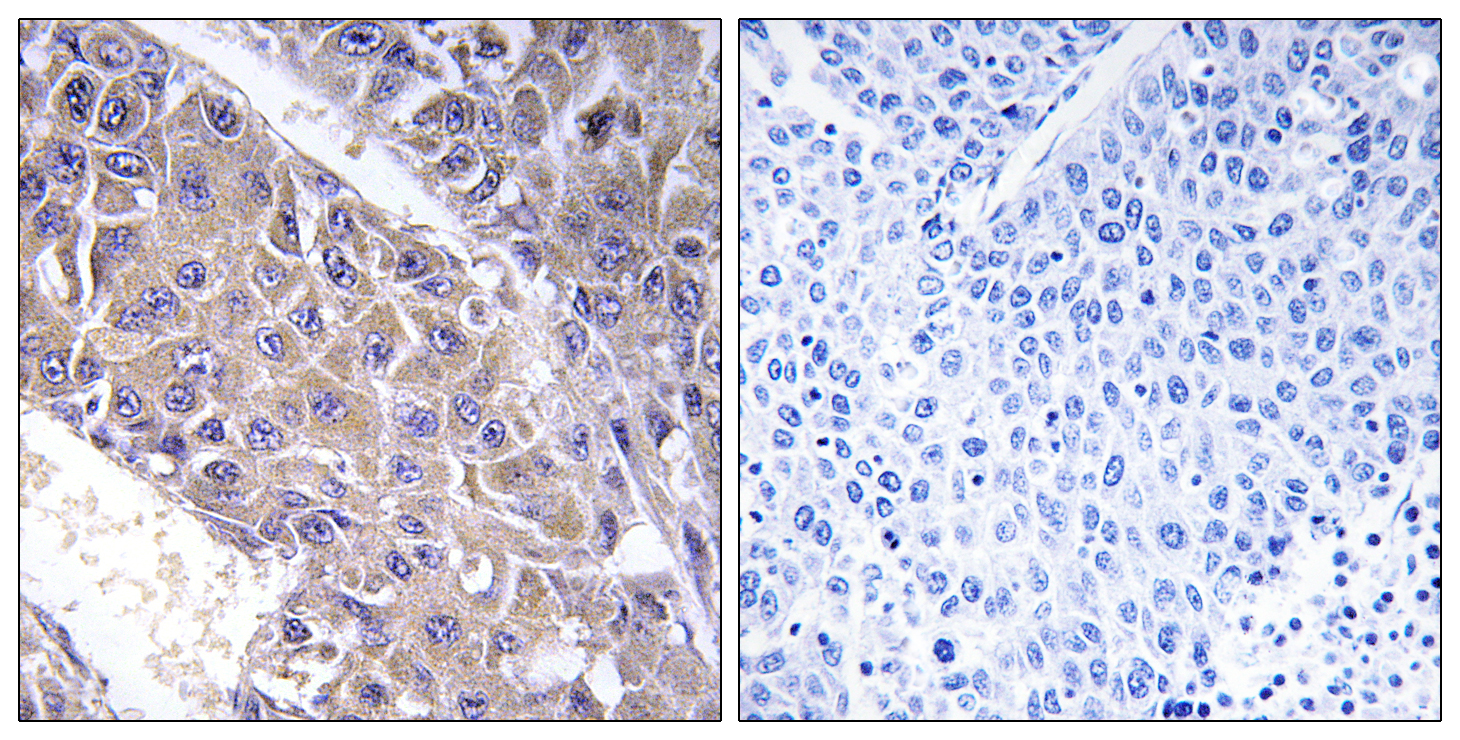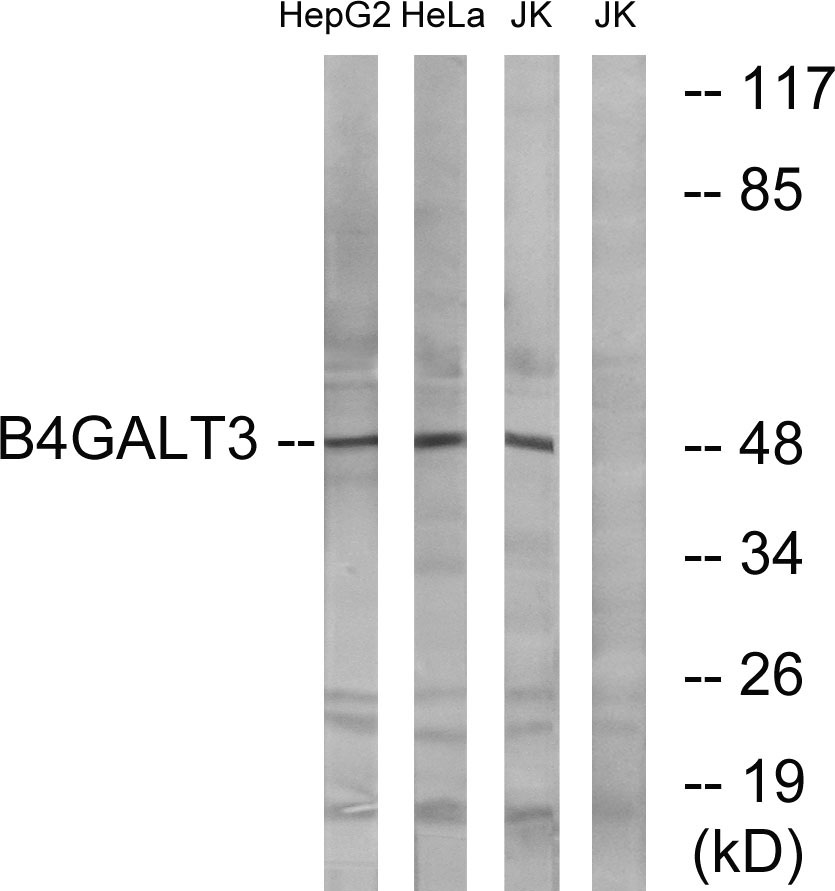β-1,4-Gal-T3 Polyclonal Antibody
- Catalog No.:YT5009
- Applications:WB;IHC;IF;ELISA
- Reactivity:Human;Mouse;Rat
- Target:
- β-1,4-Gal-T3
- Fields:
- >>N-Glycan biosynthesis;>>Various types of N-glycan biosynthesis;>>Other types of O-glycan biosynthesis;>>Mannose type O-glycan biosynthesis;>>Glycosaminoglycan biosynthesis - keratan sulfate;>>Glycosphingolipid biosynthesis - lacto and neolacto series;>>Metabolic pathways
- Gene Name:
- B4GALT3
- Protein Name:
- Beta-1,4-galactosyltransferase 3
- Human Gene Id:
- 8703
- Human Swiss Prot No:
- O60512
- Mouse Gene Id:
- 57370
- Mouse Swiss Prot No:
- Q91YY2
- Rat Gene Id:
- 494342
- Rat Swiss Prot No:
- Q6P768
- Immunogen:
- The antiserum was produced against synthesized peptide derived from human B4GALT3. AA range:271-320
- Specificity:
- β-1,4-Gal-T3 Polyclonal Antibody detects endogenous levels of β-1,4-Gal-T3 protein.
- Formulation:
- Liquid in PBS containing 50% glycerol, 0.5% BSA and 0.02% sodium azide.
- Source:
- Polyclonal, Rabbit,IgG
- Dilution:
- WB 1:500 - 1:2000. IHC 1:100 - 1:300. ELISA: 1:40000.. IF 1:50-200
- Purification:
- The antibody was affinity-purified from rabbit antiserum by affinity-chromatography using epitope-specific immunogen.
- Concentration:
- 1 mg/ml
- Storage Stability:
- -15°C to -25°C/1 year(Do not lower than -25°C)
- Other Name:
- B4GALT3;Beta-1;4-galactosyltransferase 3;Beta-1,4-GalTase 3;Beta4Gal-T3;b4Gal-T3;UDP-Gal:beta-GlcNAc beta-1,4-galactosyltransferase 3;UDP-galactose:beta-N-acetylglucosamine beta-1,4-galactosyltransferase 3
- Observed Band(KD):
- 49kD
- Background:
- This gene is one of seven beta-1,4-galactosyltransferase (beta4GalT) genes. They encode type II membrane-bound glycoproteins that appear to have exclusive specificity for the donor substrate UDP-galactose; all transfer galactose in a beta1,4 linkage to similar acceptor sugars: GlcNAc, Glc, and Xyl. Each beta4GalT has a distinct function in the biosynthesis of different glycoconjugates and saccharide structures. As type II membrane proteins, they have an N-terminal hydrophobic signal sequence that directs the protein to the Golgi apparatus and which then remains uncleaved to function as a transmembrane anchor. By sequence similarity, the beta4GalTs form four groups: beta4GalT1 and beta4GalT2, beta4GalT3 and beta4GalT4, beta4GalT5 and beta4GalT6, and beta4GalT7. This gene encodes an enzyme that may be mainly involved in the synthesis of the first N-acetyllactosamine unit of poly-N-acet
- Function:
- catalytic activity:UDP-galactose + N-acetyl-beta-D-glucosaminylglycopeptide = UDP + beta-D-galactosyl-(1->4)-N-acetyl-beta-D-glucosaminylglycopeptide.,catalytic activity:UDP-galactose + N-acetyl-D-glucosamine = UDP + N-acetyllactosamine.,cofactor:Manganese.,function:Responsible for the synthesis of complex-type N-linked oligosaccharides in many glycoproteins as well as the carbohydrate moieties of glycolipids.,online information:Beta-1,4-galactosyltransferase 3,online information:GlycoGene database,pathway:Protein modification; protein glycosylation.,similarity:Belongs to the glycosyltransferase 7 family.,subcellular location:Trans cisternae of Golgi stack.,tissue specificity:Found in various tissues. Highest expression in placenta, prostate, testis, ovary, intestine and muscle, and in fetal brain.,
- Subcellular Location:
- Golgi apparatus, Golgi stack membrane; Single-pass type II membrane protein. Trans cisternae of Golgi stack.
- Expression:
- Found in various tissues. Highest expression in placenta, prostate, testis, ovary, intestine and muscle, and in fetal brain.
Identification of a Novel Glycosyltransferase Prognostic Signature in Hepatocellular Carcinoma Based on LASSO Algorithm Front Genet. 2022 Mar 9;13:823728. WB Human
- June 19-2018
- WESTERN IMMUNOBLOTTING PROTOCOL
- June 19-2018
- IMMUNOHISTOCHEMISTRY-PARAFFIN PROTOCOL
- June 19-2018
- IMMUNOFLUORESCENCE PROTOCOL
- September 08-2020
- FLOW-CYTOMEYRT-PROTOCOL
- May 20-2022
- Cell-Based ELISA│解您多样本WB检测之困扰
- July 13-2018
- CELL-BASED-ELISA-PROTOCOL-FOR-ACETYL-PROTEIN
- July 13-2018
- CELL-BASED-ELISA-PROTOCOL-FOR-PHOSPHO-PROTEIN
- July 13-2018
- Antibody-FAQs
- Products Images

- Immunohistochemistry analysis of paraffin-embedded human liver carcinoma tissue, using B4GALT3 Antibody. The picture on the right is blocked with the synthesized peptide.

- Western blot analysis of lysates from Jurkat, HeLa, and HepG2 cells, using B4GALT3 Antibody. The lane on the right is blocked with the synthesized peptide.



